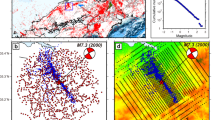Abstract
Three forms of fault are recognized in Entrada and Navajo Sandstones in the San Rafael Desert, southeastern Utah; deformation bands, zones of deformation bands, and slip surfaces. Small faults occur asdeformation bands, about one millimeter thick, in which pores collapse and sand grains fracture, and along which there are shear displacements on the order of a few millimeters or centimeters. Two or more deformation bands adjacent to each other, which share the same average strike and dip, form azone of deformation bands. A zone becomes thicker by addition of new bands, side by side. Displacement across a zone is the sum of displacements on each individual band. The thickest zones are about 0.5 m and total displacement across a thick zone rarely exceeds 30 cm. Finally,slip surfaces, which are through-going surfaces of discontinuity in displacement, form at either edge of zones of highly concentrated deformation bands. In contrast with individual deformation bands and zones of deformation bands, slip surfaces accommodate large displacements, on the order of several meters in the San Rafael Desert.
The sequence of development is from individual deformation bands, to zones, to slip surfaces, and each type of faulting apparently is controlled by somewhat different processes. The formation of zones apparently involves strain hardening, whereas the formation of slip surfaces probably involves strain softening of crushed sandstone.
Similar content being viewed by others
References
Argon, A. S., Andrews, R. D., Godrick, J. A. andWhitney, W. (1968).Plastic deformation bands in glassy polystyrene, Jour. Appl. Physics,39, 1899–1906.
Aydin, A.,Small faults formed as deformation bands in sandstone (in this issue).
Aydin, A. andJohnson, A. M.,Patterns of multiple faults in sandstone, submitted to Geologische Rundschau (in prep.,a).
Aydin, A. andJohnson, A. M.,Analysis of faults as deformation bands, zones of deformation bands, and slip surfaces in porous sandstones, submitted to Tectonophysics (in prep.,b).
Bowden, P. B. andRaha, S. (1970),The formation of micro shear bands in polystyrene and polymethyl-methacrylate, Phil. Magazine,22, 463–482.
Byerlee, J. andSummers, R. (1976),A note on the effect of fault gouge thickness on fault stability, International Journal of Rock Mechanics, Mining Science and Geomechanics Abstracts,13, 35–36.
Engelder, J. T. (1974),Cataclasis and the generation of fault gouge, Geol. Soc. America Bull85, 1515–1522.
Kramer, E. J. (1974),The stress-strain curve of shear-banding polystyrene, Jour. Micromol Sci-Phy. B,10, 191–202.
Nadai, A.,Theory of flow and fracture of solids, New York, McGraw-Hill, 1950, 571 pp.
Rodine, J. D. andJohnson, A. M. (1976),The ability of debris, heavily freighted with coarse clastic materials, to flow on gentle slopes, Sedimentology23, 213–234.
Author information
Authors and Affiliations
Rights and permissions
About this article
Cite this article
Aydin, A., Johnson, A.M. Development of faults as zones of deformation bands and as slip surfaces in sandstone. PAGEOPH 116, 931–942 (1978). https://doi.org/10.1007/BF00876547
Received:
Issue Date:
DOI: https://doi.org/10.1007/BF00876547




